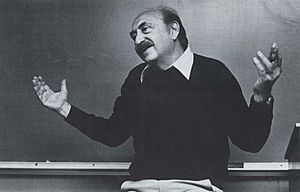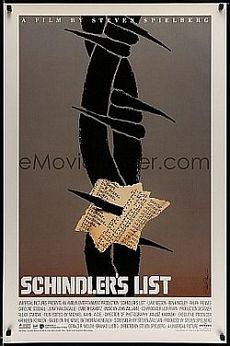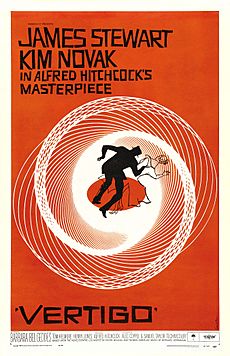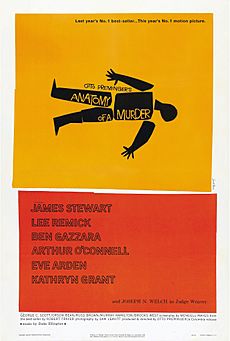Saul Bass facts for kids
Quick facts for kids
Saul Bass
|
|
|---|---|

Bass in 1979
|
|
| Born | May 8, 1920 The Bronx, New York, U.S.
|
| Died | April 25, 1996 (aged 75) Los Angeles, California, U.S.
|
| Nationality | American |
| Occupation | Graphic designer, title designer, film director |
| Spouse(s) |
Ruth Cooper
(m. 1938; div. 1960)Elaine Makatura Bass
(m. 1961) |
| Children | 4 |
| Awards |
|
| Signature | |
 |
|
Saul Bass (/bæs/; May 8, 1920 – April 25, 1996) was an American graphic designer and Oscar-winning filmmaker. He was famous for designing title sequences for movies, film posters, and corporate logos.
During his 40-year career, Bass worked with many famous Hollywood directors. These included Alfred Hitchcock, Otto Preminger, Billy Wilder, Stanley Kubrick, and Martin Scorsese.
Bass created some of the most recognizable company logos in North America. These include the Geffen Records logo (1980) and the Hanna-Barbera "swirling star" logo (1979). He also designed the last version of the Bell System logo (1969). Later, he made AT&T Corporation's first globe logo (1983). He also designed the Continental Airlines jet stream logo (1968) and United Airlines' tulip logo (1974). These became very well-known airline logos. Saul Bass passed away in Los Angeles on April 25, 1996, at 75 years old.
Contents
Early Life and Design Beginnings
Saul Bass was born on May 8, 1920, in the Bronx, New York. His parents were Jewish immigrants from Eastern Europe. He went to James Monroe High School in the Bronx. He also studied art part-time at the Art Students League of New York and Brooklyn College. In 1938, Saul married Ruth Cooper. They had two children, Robert and Andrea.
In the 1940s, Bass started working in Hollywood. He designed print ads for movies like Champion (1949). His work for Otto Preminger's film Carmen Jones (1954) was a turning point. Preminger was so impressed that he asked Bass to create the title sequence too. Bass realized this was a chance to make opening credits that would set the mood for the movie. He was one of the first to see how creative movie credits could be.
Designing Movie Title Sequences
Bass became very well known in the film industry for his title sequence for The Man with the Golden Arm (1955). It was a big hit and changed how people thought about movie openings.
For Alfred Hitchcock, Bass made memorable title sequences. He created new ways of showing text and images for films like North by Northwest (1959), Vertigo (1958), and Psycho (1960). Before Bass, movie titles were usually plain and shown on cinema curtains. Bass's work was new and exciting. He wrote an article in 1960 saying that movie credits could be a form of art. He was known for making the design of the titles fit the movie's style.
Bass said his main goal was to find a "simple, visual phrase" that showed what the movie was about. He also wanted to make everyday things look special. For example, in Walk on the Wild Side (1962), a normal cat becomes a mysterious hunter. In Nine Hours to Rama (1963), the inside of a clock becomes a huge landscape. Bass used different techniques, from cut-out animation to full mini-movies.
Sometimes, Bass's title sequences were even more praised than the movies themselves. A critic once said about The Seven Year Itch (1955), "If the film had lived up to the titles, it would have been a good picture."
In 1955, Elaine Makatura started working with Bass. She helped direct and produce title sequences. In 1961, Saul and Elaine got married. They worked together for over 30 years. They kept trying new techniques, like time-lapse photography in The Age of Innocence (1993). Their opening sequences often acted like a short introduction to the film. They would smoothly lead into the first scene.
From the mid-1960s to the late 1980s, Saul and Elaine focused more on directing films and raising their children.
In the 1980s, directors James L. Brooks and Martin Scorsese admired their work. They asked Saul and Elaine to create new title sequences. For Scorsese, they made titles for Goodfellas (1990), Cape Fear (1991), and Casino (1995). This later work used computer effects instead of older optical methods.
Screenwriter Nicholas Pileggi once said that the Basses could take a long story and turn it into a powerful four-minute opening. Today, many movie openings that set the mood for a film are inspired by Saul and Elaine Bass's work. Examples include Catch Me If You Can (2002) and the TV series Mad Men.
Famous Movie Title Sequences
|
|
Designing Logos and Brands
Bass created some of the most famous logos in North America. These include the Bell Telephone logo (1969) and the AT&T globe (1983). Other well-known designs were for Continental Airlines (1968), Dixie (1969), and United Airlines (1974). He also designed logos for many Japanese companies.
Bass's corporate logos were known for lasting a long time. Many of them only changed when the company itself went out of business or merged with another. On average, a Bass logo lasted over 34 years. In 2014, Frontier Airlines even brought back a logo Bass designed for them in 1978.
Selected Logos by Saul Bass
- Alcoa (1963)
- AT&T Corporation (1983)
- Bell System (1969)
- Boys & Girls Clubs of America (1978)
- Continental Airlines (1968)
- Dixie (1969)
- Geffen Records (1980)
- Girl Scouts of the USA (1978)
- Hanna-Barbera (1979)
- Kleenex (1962)
- Minolta (1978 and 1981)
- Quaker Oats Company (1969)
- Rockwell International (1968)
- United Airlines (1974)
- United Way (1972)
- Warner Communications (1972)
- Wienerschnitzel (1978)
Creating Movie Posters
Saul Bass also designed iconic movie posters that changed film advertising. Before Bass, movie posters usually showed scenes or characters from the film. Bass's posters used simple, symbolic designs. They showed the main idea of the film visually.
His famous Vertigo (1958) poster shows figures falling into a spiral. This captures the feeling of confusion in the movie. His poster for Anatomy of a Murder (1959) shows a body cut into seven pieces. This hints at the legal drama and moral questions in the film.
He made many of his best posters for directors like Otto Preminger, Alfred Hitchcock, and Stanley Kubrick. His last movie poster was for Steven Spielberg's Schindler's List (1993), but it was never used. Bass's poster work influenced many other designers. His posters are known for their unique text and simple style.
Selected Movie Posters by Saul Bass
1950s Posters
- Carmen Jones (1954)
- The Man with the Golden Arm (1955)
- Vertigo (1958)
- Anatomy of a Murder (1959)
1960s Posters
- Exodus (1960)
- It's a Mad, Mad, Mad, Mad World (1963)
- Bunny Lake Is Missing (1965)
1980s and 1990s Posters

- The Shining (1980)
- Schindler's List (1993) (rejected poster)
Many modern movie posters and designs pay tribute to Saul Bass's work. For example, the poster for Burn After Reading (2008) uses his style. The cover art for The White Stripes' song The Hardest Button to Button is also inspired by Bass.
Besides movie posters, Bass designed posters for film festivals, magazines, books, and album covers. He also designed five posters for the Academy Awards. In 1962, he illustrated a children's book called Henri's Walk to Paris.
Saul Bass as a Filmmaker
In the 1960s, directors asked Bass to do more than just title sequences. He also helped plan and storyboard important scenes in films. He was credited as a "visual consultant" on several movies. For Spartacus (1960), Bass designed parts of the gladiator school and planned the final battle scene. For Grand Prix (1966), he helped plan and direct most of the racing scenes.
Bass was also a "pictorial consultant" for Alfred Hitchcock's Psycho (1960). Bass suggested using quick cuts and close-ups to show the famous shower scene. This made the murder look more artistic and less bloody. He even filmed test footage to show Hitchcock how it would work.
In 1964, Saul and Elaine Bass directed a short film called The Searching Eye. They also directed a short documentary film called Why Man Creates. This film won an Academy Award for Documentary Short Subject in 1968. It was later chosen for the United States National Film Registry because it was culturally important. They directed other short films that were nominated for Academy Awards, like Notes on the Popular Arts (1977).
In 1974, Saul Bass directed his only full-length movie, a science fiction film called Phase IV. It was a visually stunning but not very well-known film about ants.
Saul Bass's Lasting Impact
Saul Bass's work is kept at the Academy Film Archive. This collection includes 2,700 film items. His papers are also at the Margaret Herrick Library. The Academy Film Archive has preserved two of his films: Why Man Creates and Notes on the Popular Arts.
On May 8, 2013, Google celebrated Bass's 93rd birthday with a special Google Doodle. It featured the song "Unsquare Dance" by Dave Brubeck.
See also
 In Spanish: Saul Bass para niños
In Spanish: Saul Bass para niños
- Motion graphics
- Paul Rand
- Pablo Ferro





